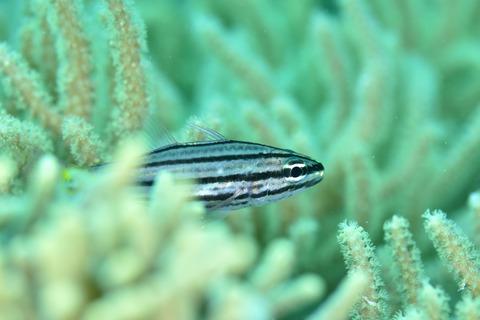当前位置:
X-MOL 学术
›
Funct. Ecol.
›
论文详情
Our official English website, www.x-mol.net, welcomes your
feedback! (Note: you will need to create a separate account there.)
Microhabitat partitioning correlates with opsin gene expression in coral reef cardinalfishes (Apogonidae)
Functional Ecology ( IF 4.6 ) Pub Date : 2020-02-16 , DOI: 10.1111/1365-2435.13529 Martin Luehrmann 1 , Fabio Cortesi 1 , Karen L. Cheney 1, 2 , Fanny Busserolles 1 , N. Justin Marshall 1
Functional Ecology ( IF 4.6 ) Pub Date : 2020-02-16 , DOI: 10.1111/1365-2435.13529 Martin Luehrmann 1 , Fabio Cortesi 1 , Karen L. Cheney 1, 2 , Fanny Busserolles 1 , N. Justin Marshall 1
Affiliation

|
Fish are the most diverse vertebrate group, and they have evolved equally diverse visual systems, varying in terms of eye morphology, number and distribution of spectrally distinct photoreceptor types, visual opsin genes and opsin gene expression levels. This variation is mainly due to adaptations driven by two factors: differences in the light environments and behavioural tasks. However, while the effects of large-scale habitat differences are well described, it is less clear whether visual systems also adapt to differences in environmental light at the microhabitat level. To address this, we assessed the relationship between microhabitat use and visual system features in fishes inhabiting coral reefs, where habitat partitioning is particularly common. We suggest that differences in microhabitat use by cardinalfishes (Apogonidae) drive morphological and molecular adaptations in their visual systems. To test this, we investigated diurnal microhabitat use in 17 cardinalfish species and assessed whether this correlated with differences in visual opsin gene expression and eye morphology. We found that cardinalfishes display six types of microhabitat partitioning behaviours during the day, ranging from specialists found exclusively in the water column to species that are always hidden inside the reef matrix. Species predominantly found in exposed microhabitats had higher expression of the short-wavelength-sensitive violet opsin (SWS2B) and lower expression of the dim-light active rod opsin (RH1). Species of intermediate exposure, on the other hand, expressed opsins that are mostly sensitive to the blue-green central part of the light spectrum (SWS2As and RH2s), while fishes entirely hidden in the reef substrate had a higher expression of the long-wavelength-sensitive red opsin. We also found that eye size relative to body size differed between cardinalfish species, and relative eye size decreased with an increase in habitat exposure. Retinal topography did not show co-adaptation with microhabitat use, but data suggested co-adaptation with feeding mode. We suggest that, although most cardinalfishes are nocturnal foragers, their visual systems—and possibly those of other (reef) fishes—have also adapted to the light intensity and the light spectrum of their preferred diurnal microhabitats. A free Plain language summary can be found within the Supporting Information of this article.
中文翻译:

微生境划分与珊瑚礁红雀鱼(Apogonidae)的视蛋白基因表达相关
鱼类是最多样化的脊椎动物群体,它们进化出同样多样化的视觉系统,在眼睛形态、光谱不同光感受器类型的数量和分布、视觉视蛋白基因和视蛋白基因表达水平方面各不相同。这种变化主要是由于两个因素驱动的适应:光环境和行为任务的差异。然而,虽然大规模栖息地差异的影响得到了很好的描述,但视觉系统是否也适应微栖息地级别的环境光差异尚不清楚。为了解决这个问题,我们评估了栖息在珊瑚礁中的鱼类的微栖息地使用与视觉系统特征之间的关系,其中栖息地划分特别常见。我们建议红雀鱼(Apogonidae)使用微生境的差异驱动其视觉系统的形态和分子适应。为了测试这一点,我们调查了 17 种主要鱼类的昼夜微栖息地使用情况,并评估这是否与视觉视蛋白基因表达和眼睛形态的差异相关。我们发现红雀鱼在白天表现出六种类型的微生境划分行为,从专门在水柱中发现的专家到总是隐藏在珊瑚礁基质内的物种。主要在暴露的微生境中发现的物种具有较高的短波敏感紫罗兰视蛋白 (SWS2B) 表达和较低的弱光活性视杆蛋白 (RH1) 表达。另一方面,中等暴露的物种,表达对光谱的蓝绿色中心部分(SWS2As 和 RH2s)最敏感的视蛋白,而完全隐藏在珊瑚礁基质中的鱼类对长波长敏感的红色视蛋白的表达更高。我们还发现,不同种类的红雀鱼相对于体型的眼睛大小不同,并且相对眼睛大小随着栖息地暴露的增加而减小。视网膜地形没有显示出与微栖息地使用的共同适应,但数据表明与喂养模式共同适应。我们认为,虽然大多数红雀是夜间觅食者,但它们的视觉系统——可能还有其他(珊瑚礁)鱼类的视觉系统——也适应了它们喜欢的昼夜微栖息地的光强度和光谱。可以在本文的支持信息中找到免费的简明语言摘要。
更新日期:2020-02-16
中文翻译:

微生境划分与珊瑚礁红雀鱼(Apogonidae)的视蛋白基因表达相关
鱼类是最多样化的脊椎动物群体,它们进化出同样多样化的视觉系统,在眼睛形态、光谱不同光感受器类型的数量和分布、视觉视蛋白基因和视蛋白基因表达水平方面各不相同。这种变化主要是由于两个因素驱动的适应:光环境和行为任务的差异。然而,虽然大规模栖息地差异的影响得到了很好的描述,但视觉系统是否也适应微栖息地级别的环境光差异尚不清楚。为了解决这个问题,我们评估了栖息在珊瑚礁中的鱼类的微栖息地使用与视觉系统特征之间的关系,其中栖息地划分特别常见。我们建议红雀鱼(Apogonidae)使用微生境的差异驱动其视觉系统的形态和分子适应。为了测试这一点,我们调查了 17 种主要鱼类的昼夜微栖息地使用情况,并评估这是否与视觉视蛋白基因表达和眼睛形态的差异相关。我们发现红雀鱼在白天表现出六种类型的微生境划分行为,从专门在水柱中发现的专家到总是隐藏在珊瑚礁基质内的物种。主要在暴露的微生境中发现的物种具有较高的短波敏感紫罗兰视蛋白 (SWS2B) 表达和较低的弱光活性视杆蛋白 (RH1) 表达。另一方面,中等暴露的物种,表达对光谱的蓝绿色中心部分(SWS2As 和 RH2s)最敏感的视蛋白,而完全隐藏在珊瑚礁基质中的鱼类对长波长敏感的红色视蛋白的表达更高。我们还发现,不同种类的红雀鱼相对于体型的眼睛大小不同,并且相对眼睛大小随着栖息地暴露的增加而减小。视网膜地形没有显示出与微栖息地使用的共同适应,但数据表明与喂养模式共同适应。我们认为,虽然大多数红雀是夜间觅食者,但它们的视觉系统——可能还有其他(珊瑚礁)鱼类的视觉系统——也适应了它们喜欢的昼夜微栖息地的光强度和光谱。可以在本文的支持信息中找到免费的简明语言摘要。











































 京公网安备 11010802027423号
京公网安备 11010802027423号